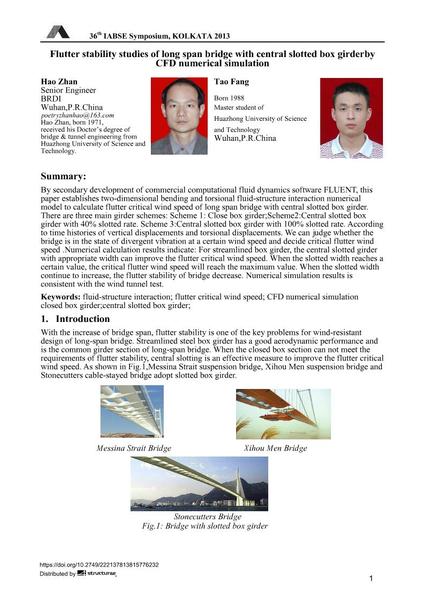Flutter stability studies of long span bridge with central slotted box girderby CFD numerical simulation

|
|
|||||||||||
Détails bibliographiques
| Auteur(s): |
Hao Zhan
Tao Fang |
||||
|---|---|---|---|---|---|
| Médium: | papier de conférence | ||||
| Langue(s): | anglais | ||||
| Conférence: | IABSE Symposium: Long Span Bridges and Roofs - Development, Design and Implementation, Kolkata, India, 24-27 September 2013 | ||||
| Publié dans: | IABSE Symposium Kolkata 2013 | ||||
|
|||||
| Page(s): | 1-8 | ||||
| Nombre total de pages (du PDF): | 8 | ||||
| Année: | 2013 | ||||
| DOI: | 10.2749/222137813815776232 | ||||
| Abstrait: |
By secondary development of commercial computational fluid dynamics software FLUENT, this paper establishes two-dimensional bending and torsional fluid-structure interaction numerical model to calculate flutter critical wind speed of long span bridge with central slotted box girder. There are three main girder schemes: Scheme 1: Close box girder;Scheme2:Central slotted box girder with 40% slotted rate. Scheme 3:Central slotted box girder with 100% slotted rate. According to time histories of vertical displacements and torsional displacements. We can judge whether the bridge is in the state of divergent vibration at a certain wind speed and decide critical flutter wind speed .Numerical calculation results indicate: For streamlined box girder, the central slotted girder with appropriate width can improve the flutter critical wind speed. When the slotted width reaches a certain value, the critical flutter wind speed will reach the maximum value. When the slotted width continue to increase, the flutter stability of bridge decrease. Numerical simulation results is consistent with the wind tunnel test. |
||||
